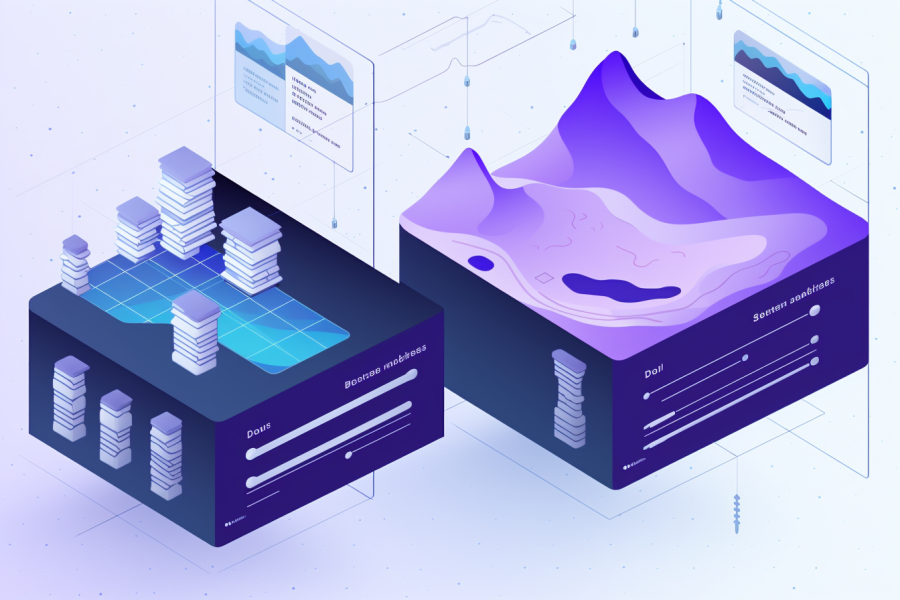
Comparing Benefits, Use Cases & Differences of Data Warehouse vs Data Lake
Imagine living in a world where you can access immense amounts of data at your fingertips to make informed decisions. Now, imagine two powerful tools that can help you store, manage, and analyze this data: data warehouses and data lakes. Both play a significant role in today’s data-driven world, but which one is the right choice for your organization? In this blog post, we will dive deep into the world of “data warehouse vs data lake”, exploring their key differences, benefits, and use cases, to help you make an informed decision.
Key Takeaways
- Comparing the distinct characteristics of data warehouses and data lakes is key to selecting the most suitable solution.
- Data warehouse offers organized & structured environment, while a data lake provides scalability, flexibility & raw insights. Each come with pros/cons.
- Factors such as types of data generated, storage requirements, analytics needs must be considered when deciding between both solutions.
Understanding Data Warehouse and Data Lake

Data warehouses and data lakes are essential components of the modern data management landscape. While data warehouses are centralized repositories for structured data, designed to optimize analytics and business intelligence operations, data lakes are vast repositories for raw, unstructured data that are suitable for machine learning and big data analytics. In the “lake vs data warehouse” debate, it’s important to understand the differences and choose the right solution for your organization’s needs.
Discerning their unique characteristics and features will guide you in determining the best solution for your organization’s data storage and analytics needs.
Data Warehouse Overview
A data warehouse is a centralized repository that stores highly structured information from multiple sources, optimized for analytics and business intelligence purposes. One of the key advantages of a data warehouse is its inherent transformation abilities, enabling data preparation to be effortless and expeditious to execute, particularly at large data scale. Data warehouses are commonly employed by mid- and large-size businesses, providing a structured and organized environment for data storage and analysis. Snowflake is an example of a Data Warehouse.
However, data warehouses may have some limitations. They can be relatively expensive to implement and maintain, and may not be as scalable as other solutions like data lakes. Additionally, data warehouses are designed to store and process structured data, which may not be suitable for organizations that require the flexibility to work with unstructured or semi-structured data.
Data Lake Overview
In contrast, a data lake is a sizable repository for raw, unstructured data that can be employed by data scientists, data engineers, and business analysts. Data lakes boast the versatility to accommodate structured, semi-structured, and unstructured data, thereby providing a more flexible environment for data storage and analysis. The primary usage of a data lake can be contingent upon the arrangement of the data, with more organized data being suitable for business analysts, and less structured data requiring the proficiency of developers, data scientists, or data engineers. Microsoft Azure Data Lake is an example of a Data Lake.
The advantages of data lakes include scalability, flexibility, and the capacity to derive insights from raw data. However, data lakes also have some disadvantages, such as neglecting data best practices and reduced data efficiency. Considering the pros and cons of data lakes is a vital step before incorporating them into your organization.
Key Differences Between Data Warehouse and Data Lake
As evident, data warehouses and data lakes possess unique characteristics and serve different objectives. In the following sections, we will explore their key differences in terms of:
- Data storage and structure
- Data processing and analysis
- Cost and scalability
- Agility and flexibility
- Security and compliance
- User types and access.
Data storage and structure is one of the key differences between data warehouses and data lakes, with data stored in distinct ways in each system.
Data Storage and Structure
One of the most notable differences between data warehouses and data lakes is how they store and structure data. Data warehouses preserve structured data, organizing it into tables and columns, whereas data lakes preserve data in its raw form, including structured, semi-structured, and unstructured data. This distinction is pivotal, as it influences the processing, analysis, and utilization of data within an organization.
For example, structured data in a data warehouse is easier to analyze and generate reports, making it suitable for business operations and decision-making. On the other hand, unstructured and semi-structured data in a data lake can be more challenging to process but offers greater flexibility for data scientists and engineers to explore and experiment with data for machine learning, big data analytics, and innovative solutions.
Data Processing and Analysis
The differences between data warehouses and data lakes also extend to data processing and analysis. Data warehouses require preprocessing and schema-on-write, which offers increased regulation of the data, potentially resulting in improved query performance. However, this approach may be less flexible and less able to accommodate changing data requirements.
In contrast, data lakes utilize schema-on-read and adaptable preprocessing, allowing for greater flexibility and agility in data processing. New data can be incorporated into the lake without necessitating a predefined schema, which is advantageous for organizations that require the ability to quickly adapt to changes in data requirements. However, this flexibility comes with potential drawbacks, such as neglecting data best practices and reduced data efficiency.
Cost and Scalability
When it comes to cost and scalability, data lakes generally have the upper hand. Storing data with big data technologies is more cost-effective than a traditional data warehouse. It helps organizations to save money in the long run. Data lakes are also designed for cost-effective storage, making them an attractive option for organizations looking to store and analyze large volumes of data without breaking the bank.
However, it’s worth noting that data warehouses can facilitate faster data analysis of structured data, proving beneficial to organizations that need quick data access for decision-making and operational activities.
Ultimately, the decision between a data warehouse and a data lake should take into account factors such as the organization’s data storage and analytics needs, budget constraints, and the desired level of scalability and performance.
Agility and Flexibility
Agility and flexibility are other key factors to consider when comparing data warehouses and data lakes. Data warehouses are less expeditious and adaptable than data lakes, as they necessitate additional time and exertion to configure and preserve. This can be a drawback for organizations that need to quickly respond to changes in data requirements or explore new data sources and analytics techniques.
On the other hand, data lakes provide superior agility and flexibility for data scientists and developers when considering data lake vs traditional data storage options. They can store and process vast amounts of raw data, allowing for greater adaptability in data processing and analysis. This can be particularly beneficial for organizations that require:
- The ability to experiment with new data sources
- The ability to experiment with new analytics techniques
- The ability to experiment with new machine learning models
Security and Compliance
In terms of security and compliance, data warehouses and data lakes differ significantly. Data warehouses are more established and secure, equipped with security features and access controls to ensure data protection and compliance. This makes them a reliable option for organizations that need to store and analyze sensitive data, such as financial records, personal information, or medical records.
On the other hand, data lakes have developing security measures and potential susceptibilities. While they can provide a flexible and scalable environment for data storage and analysis, organizations must implement additional security measures to ensure data protection and compliance. This may include implementing data encryption, access controls, and monitoring tools to safeguard data from unauthorized access and malicious attacks.
User Types and Access
Different user types and access levels are required for data warehouses and data lakes, depending on the organization’s needs. Data warehouses are typically geared towards business analysts, who can access and analyze structured data for reporting and decision-making purposes.
Data lakes, on the other hand, cater to a more diverse range of users, including:
- Data scientists
- Data developers
- Data engineers
- Data architects
The types of user access and levels needed for data warehouses and data lakes will vary depending on the organization’s requirements.
For example, some organizations may need to provide access to data lakes only for specific users, such as data scientists working on machine learning models, while others may require more widespread access for business analysts and other stakeholders. It’s important to carefully consider user types and access levels when implementing a data warehouse or data lake solution.
Choosing the Right Solution: Data Warehouse, Data Lake, or Both?

Now that we have explored the key differences between data warehouses and data lakes, it’s time to evaluate the factors to consider when choosing the right solution for your organization. This includes:
- Data types
- Storage requirements
- Analytics needs
- Budget
- Organizational goals
In some cases, a combination of both data warehouse and data lake solutions may be the most effective approach.
Factors to Consider
When choosing between a data warehouse, data lake, or a mix of both, various factors must be taken into account. These include:
- The types of data your organization generates and needs to store
- The storage requirements for your data
- The analytics needs of your organization
- Your budget constraints
- Your overall organizational goals.
For example, if your organization primarily generates and works with structured data and requires fast access to data for reporting and decision-making purposes, a data warehouse may be the most suitable solution. On the other hand, if your organization deals with a mix of structured and unstructured data and requires greater flexibility and scalability in data processing and analysis, a data lake may be more appropriate.
In some cases, combining both solutions can provide the best of both worlds, offering a comprehensive data storage and analytics solution tailored to your organization’s needs.
Combining Data Warehouse and Data Lake
Integrating a data warehouse and a data lake can offer numerous advantages for your organization, such as:
- Flexibility
- Scalability
- Cost-effectiveness
- Data exploration
By combining the structured analytics of a data warehouse with the scalability and flexibility of a data lake, your organization can quickly access and analyze data from multiple sources while still preserving control over the data.
However, there are also potential drawbacks to consider when combining data warehouse and data lake solutions. These may include:
- Issues with data quality and governance
- Complexity
- Security risks
- Lack of structure in data lakes
Evaluating the advantages and challenges of unifying a data warehouse and a data lake is a key step before adopting this strategy in your organization.
Real-Life Examples and Use Cases
Data warehouses and data lakes have been successfully implemented across various industries, demonstrating their versatility and practicality.
For instance, financial institutions employ data warehouses to:
- Store and analyze considerable volumes of financial data
- Manage transaction records
- Analyze credit histories
- Analyze market data
In contrast, oil and gas companies utilize data lakes to store and analyze large volumes of sensor data from drilling operations, production facilities, and equipment monitoring.
These real-life examples and use cases showcase the potential of data warehouses and data lakes to transform the way organizations store, manage, and analyze data. Recognizing the distinct characteristics and advantages of each solution allows organizations to make well-informed decisions on the option that best suits their needs and objectives.
Data Lakehouses and Data Marts: Hybrid Solutions
In addition to traditional data warehouses and data lakes, there are hybrid solutions available that combine the best of both worlds. Data lakehouses and data marts are two such solutions that aim to provide a comprehensive data storage and analytics solution tailored to an organization’s unique needs and goals.
Data Lakehouse Overview
A data lakehouse is a novel approach that amalgamates the analytics of data warehouses with the expansiveness and adaptability of data lakes. By combining the best of both worlds, data lakehouses can store and process large volumes of data expeditiously and economically, as well as the versatility to access and analyze data from multiple sources.
Data lakehouses can be employed for data exploration, machine learning, and analytics, providing organizations with a flexible and scalable solution for their data storage and analysis needs. By integrating the structured analytics of a data warehouse with the scalability and flexibility of a data lake, data lakehouses offer a powerful solution for organizations looking to make the most of their data.
Data Mart Overview
A data mart is:
- A subject-oriented database
- Typically a partition of an enterprise data warehouse
- A carefully organized database consisting of a set of tables
- Designed to meet the particular requirements of a single data team, community, or line of business
Data marts provide a focused view of data that is tailored to the specific requirements of a business unit or department, facilitating rapid access to data for analysis and reporting.
By employing data marts, organizations can quickly pinpoint trends and patterns in their data, enabling users to identify opportunities and make data-driven decisions. Additionally, data marts are simpler to maintain and update than a data warehouse, as they are smaller and more specific. In some cases, data marts can be utilized to quickly test new concepts and hypotheses without the necessity to construct a full data warehouse.
Best Practices for Implementing and Managing Data Warehouse and Data Lake Solutions

Though the implementation and management of data warehouse and data lake solutions can be intricate, adhering to best practices can help guarantee a favorable outcome. These best practices include:
- Establishing clear data governance policies and procedures
- Implementing robust security measures to protect data
- Developing integration strategies to connect data sources and systems to the data warehouse and data lake.
By following these best practices, organizations can maximize the benefits of their data warehouse and data lake solutions, ensuring that they effectively store, manage, and analyze data to drive better decision-making and business outcomes. With the right approach and careful planning, organizations can harness the power of data warehouses and data lakes to transform their operations and achieve their goals.
Summary
In this blog post, we delved into the realm of data warehouses and data lakes, exploring their unique characteristics, benefits, and use cases. We examined the key differences between these two powerful data storage and analytics solutions and discussed the factors to consider when choosing between them or opting for a hybrid solution. We also shared real-life examples and use cases of data warehouses and data lakes in action, demonstrating their versatility and practicality across various industries.
As the world becomes increasingly data-driven, the need for effective data storage and analytics solutions will continue to grow. Whether you choose a data warehouse, data lake, or a combination of both, understanding their unique characteristics and benefits will help you make an informed decision that aligns with your organization’s needs and goals. The future of data is vast and full of potential – make sure your organization is equipped to harness its power.
Frequently Asked Questions
Is AWS a data warehouse or data lake?
AWS provides the tools to help customers build and manage data lakes, allowing users to store and process both structured and unstructured data.
Can data lake replace data warehouse?
Data lake and data warehouse can complement each other, as they serve different use cases and have some overlap. Most organizations utilizing a data lake also employ a data warehouse.
Is Snowflake a data warehouse or lake?
Snowflake offers customers the ability to store their data in a managed repository, known as a data warehouse architecture. Additionally, customers have the flexibility to scan their data in place, functioning as a data lake. Consequently, Snowflake is both a data warehouse and a data lake.
What are the pros and cons of data lake vs data warehouse?
Data lakes contain raw, unstructured data, making it suitable for immediate or future use, while data warehouses contain structured and processed data, which is ready for analysis. Data lakehouses offer the benefits of both data lakes and data warehouses, offering a hybrid model of analytics.
What is the main difference between a data warehouse and a data lake?
The main difference between a data warehouse and a data lake is that the former is designed to optimize analytics and business intelligence operations, while the latter is suitable for machine learning and big data analytics.
Optimizing Data Solutions: Data Warehouse vs. Lake with Datrick
Understanding the nuances between Data Warehouses and Data Lakes is pivotal in today’s digital age. At Datrick, our mission is to steer organizations towards the most suitable data infrastructure, ensuring seamless growth, adaptability, and forward-thinking solutions. Feel free to schedule a consultation to review your data strategy.

